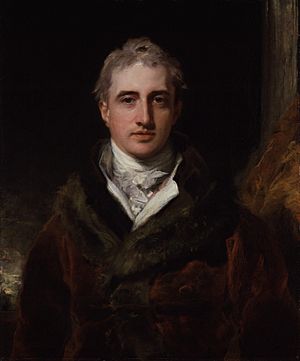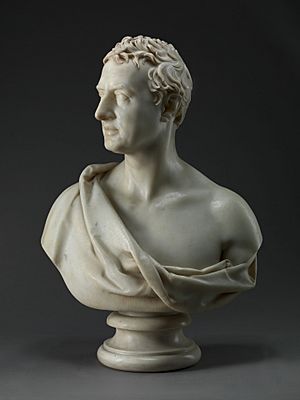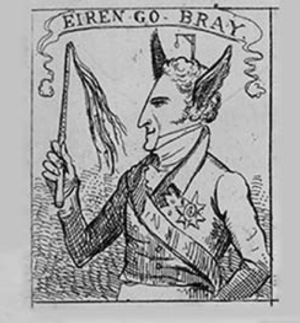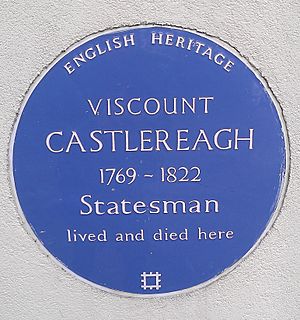Robert Stewart, Viscount Castlereagh facts for kids
Quick facts for kids
The Most Honourable
The Marquess of Londonderry
|
|
|---|---|

Portrait by Thomas Lawrence
|
|
| Secretary of State for Foreign Affairs | |
| In office 4 March 1812 – 12 August 1822 |
|
| Prime Minister | |
| Preceded by | The Marquess Wellesley |
| Succeeded by | George Canning |
| Leader of the House of Commons | |
| In office 8 June 1812 – 12 August 1822 |
|
| Prime Minister | The Earl of Liverpool |
| Preceded by | Spencer Perceval |
| Succeeded by | George Canning |
| Secretary of State for War and the Colonies | |
| In office 25 March 1807 – 1 November 1809 |
|
| Prime Minister | The Duke of Portland |
| Preceded by | William Windham |
| Succeeded by | The Earl of Liverpool |
| In office 10 July 1805 – 5 February 1806 |
|
| Prime Minister | William Pitt the Younger |
| Preceded by | The Earl Camden |
| Succeeded by | William Windham |
| President of the Board of Control | |
| In office 2 July 1802 – 11 February 1806 |
|
| Prime Minister |
|
| Preceded by | The Earl of Dartmouth |
| Succeeded by | The Lord Minto |
| Chief Secretary for Ireland | |
| In office 14 June 1798 – 27 April 1801 |
|
| Prime Minister | William Pitt the Younger |
| Lord Lieutenant | The Marquess Cornwallis |
| Preceded by | Thomas Pelham |
| Succeeded by | Charles Abbot |
| Personal details | |
| Born |
Robert Stewart
18 June 1769 Dublin, Ireland |
| Died | 12 August 1822 (aged 53) Woollet Hall, Kent, England, UK |
| Resting place | Westminster Abbey |
| Citizenship | |
| Nationality | Anglo-Irish |
| Political party | |
| Spouse | Lady Amelia Hobart |
| Parents | Robert Stewart, 1st Marquess of Londonderry Lady Sarah Frances Seymour-Conway |
| Alma mater | St. John's College, Cambridge |
| Signature | |
Robert Stewart, 2nd Marquess of Londonderry (18 June 1769 – 12 August 1822), often known as Lord Castlereagh, was an important Anglo-Irish politician. He served as the Foreign Secretary for the United Kingdom from 1812. In this role, he played a key part in defeating Napoleon and shaping Europe after the wars at the Congress of Vienna.
Earlier in his career, he helped put down the Irish Rebellion and worked to pass the Act of Union in 1800. This act joined Ireland with Great Britain. After the wars, he was seen as supporting strict rules against people asking for changes in government. He was a very busy and influential leader during a challenging time in history.
Contents
Early Life and Political Start
Robert Stewart was born on 18 June 1769 in Dublin, Ireland. His father, also named Robert Stewart, later became the 1st Marquess of Londonderry. His family had Scottish roots and became wealthy through his grandfather's marriage to an heiress from the East India Company. This wealth allowed them to buy large properties in Ireland, including Mount Stewart.
Robert's mother passed away when he was very young. His father later married Lady Frances Pratt, whose family had strong connections to important English politicians, including William Pitt the Younger. These connections helped Robert in his political career.
Education and Early Politics
Robert had some health issues as a child. He went to The Royal School, Armagh, in Ireland, instead of a school in England. Later, he studied at St. John's College, Cambridge in England. He did very well in his studies there.
In 1790, Robert was elected as a Member of the Irish Parliament for his family's area, County Down. He promised to support parliamentary reform, which meant changing how members were elected. This gained him support from many people who wanted change. He sat as an independent member, meaning he didn't join the government's side right away.
Thoughts on the French Revolution
In 1791, Robert visited France to see the French Revolution for himself. He didn't agree with the extreme views of the French nobles who had fled. While he didn't love the government in Ireland, he preferred it to a revolution. He believed that other countries shouldn't try to force a government on France. When he saw how extreme the revolution became, he worried about similar events happening in Ireland.
Supporting Pitt and the Government
When he returned to the Irish Parliament in 1793, Robert supported the Catholic Relief Bill. This bill aimed to give more rights to Catholics. He was backing the policy of British Prime Minister William Pitt the Younger, who wanted to make peace with Catholics before a war with France. Robert's loyalty to Pitt became very strong.
In 1794, Robert married Amelia (Emily) Hobart. Emily was known for being a great hostess and helped her husband during his important diplomatic missions. They were very devoted to each other but had no children.
Chief Secretary for Ireland
In 1795, Robert joined the government's side in the Irish House of Commons. His uncle, the 2nd Earl Camden, became the new Lord Lieutenant of Ireland. Robert became an important advisor to his uncle.
In 1796, Robert's father became the Earl of Londonderry, and Robert was then known as Viscount Castlereagh.
Dealing with the United Irishmen
In September 1796, Castlereagh personally led raids in Belfast to arrest leaders of the Society of United Irishmen. This group, made up of Presbyterians and Catholics, wanted to create an independent Irish republic. Some of the people he arrested had supported him in his election.
In 1797, Castlereagh was appointed to the Dublin Castle administration, which ran Ireland. He played a key role in stopping the United Irish rising in 1798. He became the Acting Chief Secretary and later the formal Chief Secretary for Ireland.
Castlereagh's approach was to offer forgiveness to most rebels but focus on the leaders. However, he gained the nickname "Bloody Castlereagh" due to some harsh actions, such as the execution of William Orr.
The Act of Union
In 1799, Castlereagh worked to unite Ireland with Great Britain to form the United Kingdom. He believed this would make Ireland more secure and help solve the "Catholic question" – the issue of giving Catholics more rights.
Castlereagh and others had promised Irish Catholics that they would be allowed to sit in the new United Kingdom Parliament. However, there was strong opposition in England, especially from King George III. Because of this, the Union bill passed without the promise of Catholic emancipation. This meant Catholics still couldn't hold certain political positions.
Both Castlereagh and Prime Minister Pitt resigned because they couldn't keep their promise about Catholic rights. Many Catholics in Ireland blamed Castlereagh for this broken promise.
President of the Board of Control
In 1802, Castlereagh joined the British Cabinet as President of the Board of Control. His main job was to manage affairs in British India. He worked to resolve disagreements between the Governor-General of India and the East India Company.
Efforts for Ireland
Even with his new responsibilities in London, Castlereagh still wanted to help Ireland. He tried to stop violence between different religious groups and ensure loyalty to the Crown. He also tried to change how Presbyterian ministers were paid to encourage loyalty.
In 1805, Castlereagh lost his parliamentary seat in County Down because many people, including former United Irishmen, were still angry about the Act of Union and the broken promise to Catholics. He then found a new seat in England.
Secretary for War
When Napoleon's wars restarted, Castlereagh became Secretary of State for War and the Colonies in 1804 under Prime Minister Pitt. He worked on military reforms and supported aggressive military actions.
In 1807, he became Secretary of State for War again. He agreed to a British attack on Copenhagen, Denmark, to prevent their fleet from falling into French hands. This led to a war with Russia and Denmark joining forces with France.
Disagreement with George Canning
In 1809, Castlereagh had a major disagreement with the Foreign Secretary, George Canning, over a military expedition called the Walcheren Expedition. Canning claimed he opposed the plan, but evidence later suggested he had interfered with it. The disagreement became so intense that Castlereagh challenged Canning to a duel.
The duel took place on 21 September 1809. Castlereagh wounded Canning in the leg. Both men were forced to resign from the government due to the scandal. Many people later felt that Castlereagh had been unfairly treated by Canning.
Foreign Secretary and European Peace
Three years later, in 1812, Castlereagh returned to government as the Foreign Secretary. He held this important role for the next ten years. He also became the leader of the House of Commons.
Building Alliances Against Napoleon
As Foreign Secretary, Castlereagh was crucial in forming the alliance between Britain, Austria, Russia, and Prussia in 1814. This alliance was key to defeating Napoleon. He also helped negotiate the Treaty of Paris, which brought peace with France.
Historians believe that Castlereagh's strong character and clear goals helped keep these powerful countries united against Napoleon. It's possible that without his leadership, Napoleon might not have been defeated and France might not have returned to its original borders.
The Congress of Vienna
At the Congress of Vienna (1814–1815), Castlereagh proposed a system for keeping peace in Europe, called the Congress system. This system involved the main European powers meeting regularly to discuss and manage international affairs. He believed that a harsh peace treaty against France would upset the balance of power in Europe. France was restored to its 1791 borders, and its colonies were returned.
The Congress system was used for about ten years to solve disputes, but it eventually broke down due to disagreements between Britain, Austria, and Russia.
Ending the Slave Trade
Castlereagh also played a significant role in the international effort to end the Atlantic slave trade. While Britain had abolished its own slave trade in 1807, Castlereagh worked to get other countries to agree to stop it too. He signed treaties with Portugal, Sweden, and Denmark. The Congress of Vienna also included a statement condemning the slave trade.
He worked with the Royal Navy to capture slave ships and send the freed slaves to Sierra Leone. He faced challenges with countries like the United States, Spain, France, and Portugal, who relied on the slave trade for their colonies. Castlereagh's diplomatic efforts laid the groundwork for the eventual end of the Atlantic slave trade.
Policy of Non-Intervention
In 1820, Castlereagh introduced a major policy paper that guided British foreign policy for the rest of the century. He argued that Britain should not intervene in every conflict on the European continent. He believed that the main purpose of the Quadruple Alliance was to contain France and stop major revolutions, not to interfere in every small uprising. He also noted that the British public would not support constant interventions.
Public Opinion and Later Years
Despite his successes in foreign policy, Castlereagh became very unpopular in Britain. He was criticized for supporting strict governments in Europe and for his role in the divorce proceedings of George IV and Queen Caroline. He was also linked to harsh measures taken by the Home Secretary at home. As the leader of the House of Commons, he often had to defend the government's policies, which made him a target for criticism.
The Irish poet Thomas Moore often wrote satirical poems and stories that made fun of Castlereagh. These writings accused Castlereagh of betraying Ireland and deceiving Catholics during the Act of Union. These criticisms reportedly upset Castlereagh deeply.
After his father passed away in 1821, Castlereagh became the 2nd Marquess of Londonderry. He continued to work tirelessly, managing both his parliamentary duties and complex international diplomacy.
Decline and Death
By 1822, Castlereagh was showing signs of extreme stress and mental exhaustion. He was severely overworked from his responsibilities leading the government in the House of Commons and constantly dealing with international conflicts.
On 12 August 1822, Castlereagh died at his home, Woollet Hall, in Kent, England. He had been suffering from severe mental distress and overwork. His death was a shock to many. Experts later suggested his condition was due to intense stress and a severe depressive illness.
Memorials
Several places in Australia were named after Lord Castlereagh:
- Castlereagh Street in Sydney, named in 1810.
- The Sydney suburb of Castlereagh, also named in 1810.
- The Castlereagh River in New South Wales, named in 1818.
- The former electoral seat of Castlereagh (1904–1991).
See also
 In Spanish: Robert Stewart, vizconde de Castlereagh para niños
In Spanish: Robert Stewart, vizconde de Castlereagh para niños
- Lord Castlereagh (ship), two ships named for Lord Castlereagh





